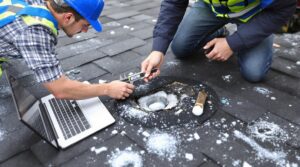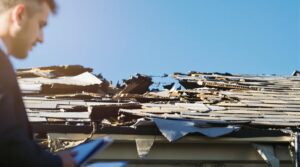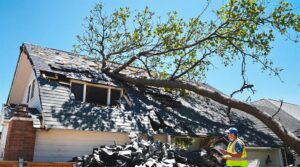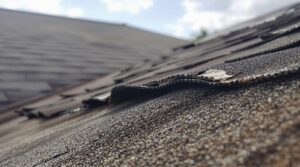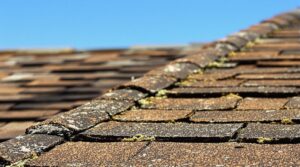Wondering if you can pocket that roof insurance money? Let's set the record straight!
Think of insurance claim funds like a designated gift card – it's specifically meant for fixing your roof, not for splurging elsewhere. While that check might look tempting in your bank account, using it for anything besides roof repairs is actually walking into dangerous territory.
Why? Because keeping insurance money without fixing your roof is insurance fraud – and trust me, that's not a club you want to join. We're talking serious consequences here: hefty fines that could hit $100,000, possible jail time, and a criminal record that'll follow you around like a storm cloud.
Your insurance company isn't just taking your word for it, either. They'll want to see receipts, photos, and documentation proving you've put that money where it belongs – on your roof! And if you've got a mortgage? Your lender will likely be right there on the settlement check, making sure those funds go straight to repairs.
Need help navigating this process? Public adjusters are like your personal insurance translators. They'll help you get every penny you deserve while keeping everything above board and compliant. Remember, the goal isn't just to get your roof fixed – it's to do it right and legal!
Smart tip: Document everything from day one – from initial damage photos to final repair receipts. Your future self will thank you for staying organized and transparent throughout the process.
Key Takeaways
Wondering What Happens to Your Roof Insurance Money?
Let's talk about that insurance check burning a hole in your pocket. Think of your roof claim money like a designated driver – it has one specific job, and that's getting your roof fixed!
Think twice before treating that insurance payout like a windfall. Here's the real deal:
It's Not Your Personal Piggy Bank
Just as you wouldn't use your company expense account for a vacation, insurance money comes with strings attached. You're legally required to use it for roof repairs, or you could face serious fraud charges.
The Paper Trail Matters
Your insurance company isn't just taking your word for it. They'll want receipts, photos, and proof that your new roof is more than just a figment of your imagination. Plus, if you've got a mortgage, your lender will likely want to co-sign that check.
Playing by the Rules
Trying to pocket the money? That's like running a red light – there are consequences. We're talking potential six-figure fines, jail time, and saying goodbye to your insurance coverage.
The Numbers Game
Your roof's value drops over time, just like your car. Different materials age differently – some might lose 1% yearly, others up to 4%. This depreciation affects your final settlement amount.
Bottom Line
Want to stay on the right side of the law? Keep detailed records, work with licensed contractors, and document everything. Remember, this money isn't a gift – it's a repair fund with a very specific purpose.
Understanding Insurance Claim Money for Roof Damage
Nearly every homeowner will face the prospect of filing an insurance claim for roof damage at some point. Understanding how insurance claims work for roof damage is essential for successful policy compliance and maximum coverage.
The process begins with a thorough damage assessment by an insurance adjuster who determines if the damage falls under policy coverage. Typically, sudden and accidental damage from events like wind, hail, or lightning qualifies for coverage, while normal wear and tear does not.
Documentation plays a vital role, requiring photographs, detailed reports, and professional estimates from roofing contractors. Insurance companies may also cover interior water damage resulting from roof problems, though flood damage usually requires separate coverage. Success in roof insurance claims often depends on proper documentation, timely reporting, and clear communication with adjusters. Hiring a public adjuster can increase claim settlements by up to 574% compared to filing independently.
Legal Requirements and Obligations
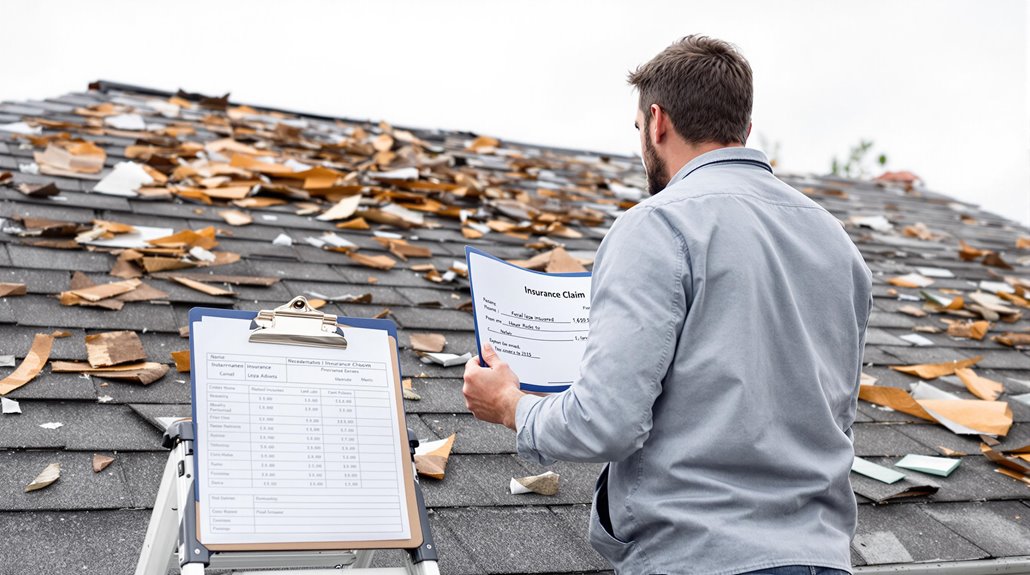
When homeowners receive insurance claim money for roof damage, they must adhere to strict legal requirements and obligations regarding its use. Insurance settlements are specifically designated for repairing or replacing damaged roofs, and policyholders have legal obligations to use these funds for their intended purpose.
Failure to comply can result in serious consequences, including financial penalties, policy cancellation, and potential legal action.
Insurance companies may require proof that repairs were completed according to the settlement terms. If policyholders misuse the claim money or fail to make the necessary repairs, they may be required to repay the settlement and could face denial of future claims.
Additionally, insurance companies must act in good faith during the claims process, and policyholders have the right to dispute settlements through legal channels if necessary.
Working with public adjusters can increase settlement amounts by up to 800% and help ensure proper claim documentation.
Proper Use of Roof Insurance Settlements

Insurance settlements for roof repairs come with specific legal obligations that homeowners must understand and follow when using the disbursed funds.
Insurance companies require thorough documentation of all repairs, including receipts, contractor agreements, and photographic evidence to guarantee proper use of settlement money.
Misusing insurance claim funds or failing to complete the specified repairs can result in policy cancellation, legal consequences, and potential recovery actions by the insurance company.
Working with public insurance adjusters can increase settlement amounts by 20-50% while ensuring proper documentation and compliance with policy requirements.
Legal Requirements and Obligations
Legal obligations surrounding roof insurance settlements involve a complex network of responsibilities between homeowners, insurance carriers, and mortgage companies.
Homeowners must adhere to strict legal precedents when receiving insurance proceeds, particularly when there is an outstanding mortgage. Insurance carriers typically include mortgage companies on settlement checks, recognizing their vested interest in the property.
Liability concerns arise when homeowners consider alternative uses for settlement funds. The law requires that insurance proceeds be used specifically for their intended purpose – repairing or replacing the damaged roof.
Mortgage holders maintain oversight rights and may supervise the repair process, especially for complex repairs requiring specialized contractors. Failure to comply with these obligations can result in policy cancellation, legal consequences, and potential credit damage.
Working with public insurance adjusters can increase claim settlements by 20-50% compared to self-managed claims while ensuring proper documentation and compliance.
Documentation and Repair Records
Meticulous documentation and record-keeping form the foundation of proper roof insurance settlement management.
Insurance companies require thorough photographic evidence and detailed written reports for damage verification.
Several key documentation elements must be maintained throughout the claims process.
- Complete photo documentation of all visible roof damage, including missing shingles, structural issues, and any collateral damage to gutters or siding
- Multiple detailed repair estimates from licensed and insured contractors, specifying all necessary repairs and replacements
- Copies of all correspondence with insurance adjusters, contractors, and other involved parties
- Records of settlement calculations based on the roof's age and replacement value
Maintaining organized documentation guarantees transparency and helps facilitate smooth processing of insurance claims while protecting homeowners' interests in receiving appropriate compensation for roof repairs.
Working with public adjusters can increase insurance claim settlements by up to 800% through their expertise in assessment and documentation.
Consequences of Misusing Funds
When homeowners receive insurance settlements for roof damage, they must adhere to strict guidelines regarding the use of these funds or face serious consequences. Misappropriation of insurance payouts can trigger claim investigations and result in significant monetary penalties. Insurance providers actively monitor repair completion and may require documentation to verify proper fund allocation.
| Consequence | Impact |
|---|---|
| Legal Action | Insurance fraud charges and prosecution |
| Policy Status | Cancellation of coverage and denial of future claims |
| Financial Impact | Required return of funds and monetary penalties |
| Property Value | Decreased home value due to unrepaired damage |
| Future Insurance | Difficulty obtaining new coverage and higher premiums |
The ramifications extend beyond immediate financial consequences, potentially affecting homeowners' ability to maintain adequate insurance coverage and preserve their property's value. Insurance companies may also pursue legal action to recover misused funds and enforce policy terms. Working with public insurance adjusters can help ensure proper settlement amounts and compliance with policy requirements.
Consequences of Misusing Insurance Funds

Misusing insurance claim money intended for roof repairs can result in severe legal consequences, including hefty fines up to $100,000 and potential imprisonment for insurance fraud.
Insurance companies may cancel existing policies and place individuals in high-risk categories, making future coverage more expensive or impossible to obtain.
Special investigative units actively pursue cases of insurance fund misuse, leading to criminal records and mandatory restitution payments for those found guilty of fraudulent activities.
Public adjusters can help ensure proper use of claim funds and increase settlement amounts by 30-50% through objective damage assessment.
Legal Penalties and Fines
Insurance fraud and misappropriation of claim funds carry severe legal consequences under both federal and state laws.
Individuals who misuse insurance money intended for roof repairs face potential criminal charges and federal prosecution, with penalties including substantial fines and imprisonment up to 15 years.
Key violations that trigger legal action include:
- Filing false claims or providing misleading information about roof damage
- Misappropriating insurance funds meant for repairs
- Staging or fabricating roof damage incidents
- Obstructing insurance examinations or investigations
Beyond criminal penalties, offenders may face civil lawsuits from insurance companies seeking to recover damages and costs.
These legal actions often result in court-ordered restitution payments and can leave perpetrators with a permanent criminal record that impacts future insurance and employment opportunities.
Working with public adjusters can help ensure legitimate claims are properly documented and valued, reducing the risk of legal issues.
Insurance Policy Cancellation
The consequences of mishandling claim funds extend far beyond immediate financial penalties, as policyholders face the severe risk of insurance policy cancellation. Insurance providers may initiate coverage termination due to misrepresentation, fraud, or failure to comply with policy terms when managing claim funds. This can result in policy expiration before the intended term completion.
Such cancellations create significant long-term repercussions for policyholders. Insurance companies maintain permanent records of these terminations, often categorizing affected individuals as high-risk clients. This classification typically leads to increased premiums on future policies, difficulty securing new coverage, and potential denial of subsequent claims.
Additionally, policyholders may face financial setbacks through the loss of loyalty discounts, coverage gaps, and the obligation to pay higher rates due to their elevated risk status. Homeowners can protect themselves by working with public adjuster professionals who understand policy regulations and help ensure proper claims handling.
Fraud Investigation Risks
When policyholders misappropriate insurance claim funds, they expose themselves to thorough fraud investigations that can lead to severe legal consequences.
Insurance companies employ sophisticated detection techniques and rigorous investigative protocols to identify potential fraud, including document analysis, interviews, and surveillance.
The consequences of misusing insurance funds can be substantial:
- Criminal charges resulting in fines and possible imprisonment
- Legal action by insurance companies to recover damages
- Permanent criminal record affecting future employment
- Higher insurance premiums and difficulty obtaining coverage
Insurance investigators meticulously review claim documentation, conduct witness interviews, and analyze evidence to verify the legitimate use of funds.
This extensive approach helps protect the integrity of the insurance system while ensuring that fraudulent activities are identified and appropriately addressed through legal channels.
Claims management systems and data analytics tools enable insurance companies to systematically identify suspicious patterns and discrepancies in claims.
Your Rights as a Policyholder

Understanding policyholder rights serves as an essential foundation for successfully maneuvering insurance claims for roof damage. Policy understanding encompasses several key elements, including the right to file claims, receive prompt investigations, and obtain fair compensation for covered damages.
Policyholders are entitled to thorough investigations of their roof damage claims and clear explanations of any decisions made by their insurance company.
When taking rightful actions, property owners can appeal claim denials, provide additional evidence to support their case, and negotiate payment amounts.
Insurance companies must handle these processes fairly and promptly, providing written explanations for denials and detailed justifications for payment amounts. If dissatisfied with the outcome, policyholders retain the right to seek legal assistance and dispute resolution options to guarantee they receive appropriate compensation for their roof damage.
Documentation and Record-Keeping Requirements

Proper documentation and record-keeping form the backbone of successful roof insurance claims. Insurance providers require thorough photographic evidence and detailed records to process claims effectively.
A systematic approach to record management guarantees all necessary documentation is readily available when needed.
Key documentation requirements include:
- Clear, dated photographs showing damage from multiple angles
- Written records of all interactions with insurance adjusters and contractors
- Formal documentation of damage circumstances and weather conditions
- Supporting evidence such as witness statements and prior roof assessments
Maintaining organized records throughout the claims process helps protect policyholder interests and facilitates smoother claim settlements.
Digital copies of all submitted materials should be retained, along with the assigned claim number, to establish a complete documentation trail for future reference.
Working With Contractors and Insurance Adjusters

The process of working with contractors and insurance adjusters requires careful coordination to guarantee a successful roof insurance claim.
Homeowners should select licensed and insured roofing contractors who can provide detailed estimates and effectively communicate with insurance adjusters during property inspections.
Clear documentation of contract terms, payment schedules, and scope of work helps establish proper expectations between all parties while maximizing the potential insurance payout.
Choosing Reputable Roof Contractors
Selecting a reputable roofing contractor plays a pivotal role in successfully managing insurance claim repairs.
When evaluating potential contractors, homeowners should prioritize contractor credentials and quality assurance through proper licensing, insurance coverage, and industry certifications. Verification through the Better Business Bureau and local chambers of commerce helps guarantee legitimacy.
Key factors to examine when choosing a roofing contractor:
- Written estimates detailing specific work scope and associated costs
- Proof of liability insurance and worker's compensation coverage
- Experience handling insurance claims and working with adjusters
- Valid licenses and additional industry certifications
Obtaining referrals from trusted sources and checking online reviews provides additional confidence in contractor selection.
Meeting contractors in person allows homeowners to assess their professionalism and understanding of the project requirements.
Property Adjuster Meeting Tips
Successfully maneuvering meetings with property claim adjusters requires careful preparation and a clear understanding of roles and responsibilities.
Homeowners should assemble all relevant documentation, including insurance policies, photographs of damage, and proof of property value before the meeting.
Professional adjuster attire often signals a formal inspection, so homeowners should be prepared for a thorough examination.
During the inspection, homeowners should focus on damage specifically related to the insured event, avoiding discussions about pre-existing issues.
Meeting preparation should include maintaining detailed records of all interactions and having a clear understanding of policy coverage.
One must recognize that adjusters work for insurance companies, not homeowners, while maintaining a cooperative approach to achieve fair claim settlements through honest communication and proper documentation.
Contract and Payment Terms
Managing contract and payment terms for roof insurance claims requires a clear understanding of the multi-party payment process.
Insurance companies often operate on specific payment cycles and disbursement schedules, which may involve multiple checks and various stakeholders.
Homeowners should be aware of how payments are handled, particularly when mortgage lenders or property management companies are involved.
Key aspects of the payment process include:
- Insurance companies may use sliding scale payments based on roof age
- Lenders might require check endorsement or establish escrow accounts
- Contractors may receive direct payments through "direction to pay" forms
- Final payments typically occur after completion and satisfaction verification
Understanding these terms helps guarantee smooth claim processing and appropriate fund distribution while protecting all parties' interests in the repair process.
Payment Schedules and Disbursement Methods

Understanding insurance claim payment schedules for roof damage requires familiarity with multiple disbursement methods and timelines. Insurance providers typically structure payment progression based on either Actual Cash Value (ACV) or Replacement Cost (RC) schedules, with specific percentages determined by the roof's age and material type.
The disbursement timing follows preset calculations, with metal roofs decreasing 1% annually up to 30% at 30 years, tile roofs at 2% yearly up to 60%, and shingle roofs at 4% per year up to 75% at 19 years.
These schedules apply specifically to damage from wind and hail events, while other home-related claims remain under standard replacement cost coverage. Final settlement amounts factor in applicable deductibles and are adjusted according to the chosen payment schedule.
Inspection and Verification Protocols
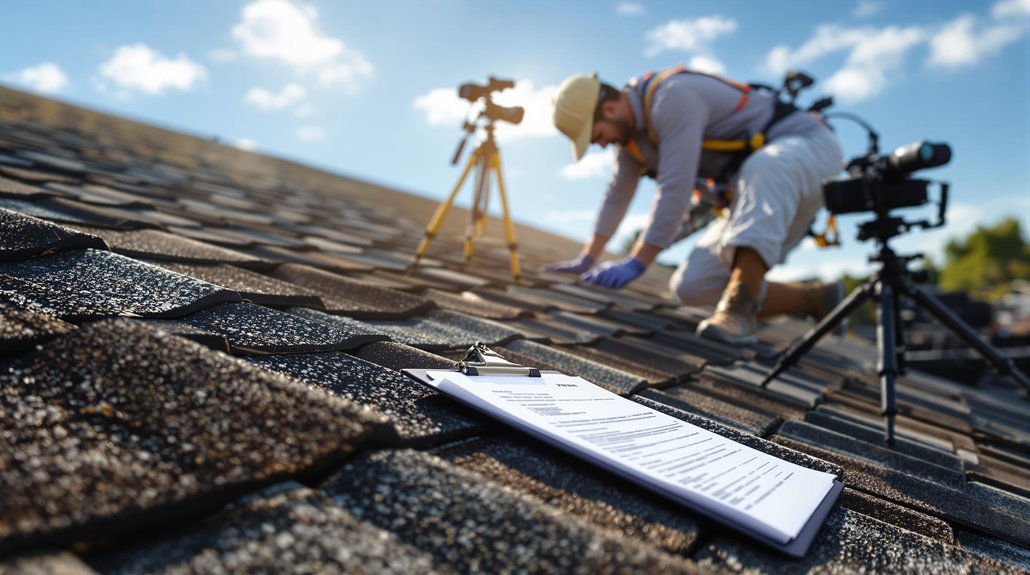
Insurance claim inspections require thorough evaluation protocols to accurately assess and verify roof damage.
Licensed professionals follow standardized inspection protocols and verification standards to guarantee complete documentation for insurance claims.
The process includes detailed structural examinations, material assessments, and interior evaluations.
Key components of the verification process include:
- Professional assessment of structural integrity, including roof planes, gutters, and chimneys
- Thorough documentation through photographs and detailed reports
- Evaluation of roofing materials for damage, wear, and deterioration
- Interior inspection for water damage and related issues
All findings must be properly documented using standardized forms and submitted promptly to insurance companies.
This systematic approach guarantees accurate damage assessment and supports valid insurance claims while maintaining consistency throughout the verification process.
Common Claim Settlement Disputes

Roof insurance claim settlements frequently encounter disputes between property owners and insurance providers, leading to complex resolution processes. Common procedural disputes arise from policy misinterpretation, delayed processing, and coverage denials, while valuation conflicts often stem from disagreements over repair costs and damage assessments.
When disputes occur, resolution typically follows a progressive path starting with direct negotiation between parties. If unsuccessful, mediation or arbitration may be pursued through neutral third parties.
Some cases require professional appraisals to establish fair compensation values. In instances where alternative methods fail, litigation becomes necessary, though this path involves significant time and expense.
Understanding policy terms, maintaining thorough documentation, and engaging in clear communication can help prevent or minimize claim settlement disputes.
The Benefits Of Consulting A Public Adjuster
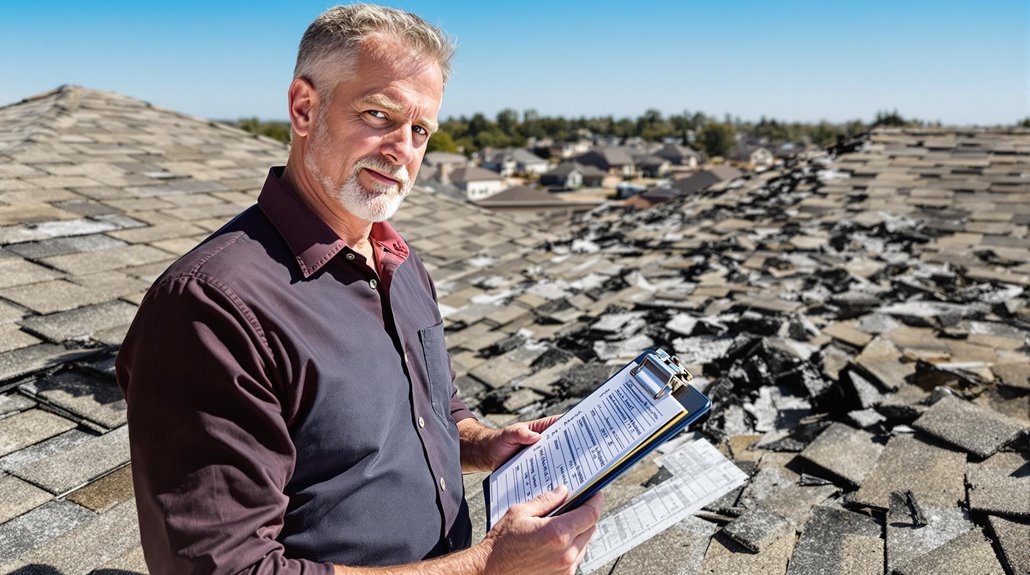
Public adjusters bring specialized expertise to roof insurance claims, offering objective damage assessments and thorough knowledge of policy coverage.
Their professional involvement streamlines the claims process by managing documentation, inspections, and negotiations with insurance carriers.
Studies indicate that policyholders who work with public adjusters typically receive substantially higher claim settlements compared to those who handle claims independently.
Expertise In Insurance Claims
When dealing with complex roof damage claims, consulting a public adjuster can provide invaluable expertise and substantially improve claim outcomes.
These professionals possess extensive knowledge in claim interpretation and negotiation skills, ensuring policyholders receive fair compensation for their roof damage.
Public adjusters offer several key advantages in the claims process:
- In-depth analysis of insurance policies to identify all applicable coverage
- Thorough documentation of roof damage and supporting evidence
- Expert negotiation with insurance companies to maximize settlement value
- Professional representation throughout the entire claims process
Their expertise helps prevent common pitfalls that could result in claim denials or reduced settlements.
Public adjusters understand the complexities of policy language and can effectively advocate for policyholder rights, making them valuable allies during insurance claim disputes.
Objective Damage Assessment
Conducting an objective damage assessment stands as a crucial first step in maximizing insurance claim settlements for roof damage. This process requires thorough documentation through photographs, videos, and detailed written reports that capture the full scope of structural damage.
A complete structural analysis examines all affected components, from shingles and flashing to underlying support systems.
Professional damage estimation involves meticulous evaluation of both visible and hidden issues that may impact the roof's integrity. The assessment includes supporting documentation such as repair estimates, maintenance records, and contractor evaluations to establish the full extent of the damage.
This detailed approach creates a solid foundation for claim negotiations, ensuring that all damage is properly identified, documented, and factored into the final settlement amount.
Streamlined Claim Process
Leveraging the expertise of a public adjuster transforms the insurance claim process into a streamlined and efficient experience for property owners facing roof damage.
These professionals manage all aspects of the claim, from simplified documentation to expedited filing, ensuring accuracy and completeness throughout the process.
A public adjuster's systematic approach includes:
- Thorough gathering and organization of required paperwork
- Professional assessment and documentation of all roof damage
- Direct communication and negotiation with insurance carriers
- Regular status updates to keep property owners informed
Higher Claim Payouts & Settlements
One of the most significant advantages of hiring a public adjuster for roof insurance claims is the potential for substantially higher claim settlements. Through their claim expertise, public adjusters conduct thorough payout analysis to identify all eligible damages and guarantee complete coverage.
Their in-depth knowledge of insurance policies and procedures enables them to interpret coverage terms accurately and counter tactics that might minimize settlements.
Public adjusters excel in documenting damage extensively and presenting claims effectively, supporting their assessments with detailed evidence. Their negotiation skills prove invaluable when dealing with insurance companies, often securing settlements that exceed what policyholders might obtain on their own.
About The Public Claims Adjusters Network (PCAN)
The Public Claims Adjusters Network (PCAN) represents a complete alliance of licensed insurance claim professionals who advocate for policyholders during property damage claims.
With extensive Network Coverage and Global Operations, PCAN provides all-encompassing services across multiple countries and throughout the United States.
These professional adjusters deliver specialized expertise through:
- Independent assessment of property damage and accurate valuation
- Strategic negotiation with insurance companies for maximum settlements
- Thorough review and interpretation of insurance policies
- Complete management of claim documentation and communication
PCAN adjusters work solely for policyholders, not insurance companies, ensuring unbiased representation throughout the claims process.
Their services often result in higher settlements while reducing the stress and complexity typically associated with insurance claims.
Frequently Asked Questions
Can I Use Roof Insurance Money for Solar Panel Installation?
Insurance claim money must be used specifically for roof repairs. While solar savings are attractive, installation requirements mandate separate funding for solar panels through appropriate financing channels.
How Long Does Unused Roof Claim Money Stay Valid?
Like ancient scrolls with expiry dates, roof claim money typically maintains payment validity for 180 days after issuance, though specific expiration terms vary by insurance company and policy requirements.
What Happens if Repair Costs Are Less Than Insurance Payment?
When repair costs are lower than insurance payments, homeowners should notify their insurer about remaining funds. The surplus savings may need to be returned according to policy terms and requirements.
Can Insurance Claims Affect Future Premiums for Unrelated Coverage Types?
Insurance claims can influence premium calculations across different coverage types, as insurers often consider overall risk profiles when determining rate adjustments, even for unrelated policies within the same company.
Are DIY Roof Repairs Acceptable Under Insurance Claim Settlements?
DIY roof repairs typically violate insurance policy Safety Requirements and void Warranty Impact protections. Most insurers require professional contractors for claim settlements to guarantee proper repairs and maintain coverage validity.
References
- https://www.billraganroofing.com/blog/should-file-claim-roof-damage
- https://www.cag.edu.tr/uploads/site/lecturer-files/387-2-english-vocabulary-in-use-pre-intermediate-and-intermediate-redman-2017-4th-264p-sayfalar-silindi-3br9.pdf
- https://blog.homesteadroofingcolorado.com/what-if-i-keep-my-insurance-claim-money
- https://bayanebartar.org/file-dl/library/IELTS2/IELTS-Writing-Maximiser.pdf
- https://www.lanelaw.com/insurance-claim-denied/blog/your-guide-to-understanding-the-roof-insurance-claim-process
- https://www.billraganroofing.com/blog/things-expect-when-filing-insurance-claim-roof-damage
- https://www.bogleheads.org/forum/viewtopic.php?t=409237
- https://www.youtube.com/watch?v=uOssPt4EyfU
- https://reddiamondroof.com/blog/when-nature-strikes-how-to-navigate-the-complexities-of-roof-insurance-claims-for-storm-damage/
- https://roofingrenovationstn.com/8-steps-to-filing-an-insurance-claim-for-your-roof/

